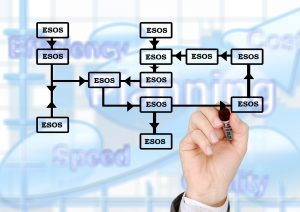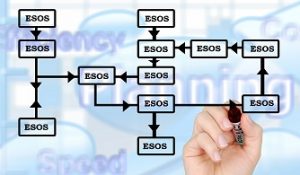Do you have what it takes to become an ESOS Lead Assessor?
ESOS Lead Assessors play a fundamental role in the ESOS cycle by ensuring that organisations/clients complete their ESOS compliance project to budget and by its deadline. As the ESOS compliance deadline is looming closer (5th December 2019), the demand for these skilled professionals is increasing. But how do you increase your professional status to become a registered ESOS Lead Assessors?
The common path in becoming an ESOS Lead Assessor is to register with one of the Registers of ESOS Lead Assessors approved by the Environment Agency. Every Register has different conditions and stages of approving Lead Assessors. However, the common denominator for all is that they expect the candidates to demonstrate a minimum length of at least two years of good quality relevant professional energy assessment and energy audit experience relevant to the PAS 51215 competencies.
Required competencies of ESOS Lead Assessors as described in PAS 51215:2014
| No. | Core competencies |
| A1 | Understanding the operational context of the organisation being assessed |
| A2 | Familiarity with, and ability to apply, the requirements of energy efficiency assessment methods |
| A3 | Scoping an energy efficiency assessment, as applicable to the organisation being assessed |
| A4 | Understanding, in detail, energy use and energy systems applicable to the organisation being assessed |
| A5 | Managing energy efficiency assessment teams and budgets |
| A6 | Understanding the techniques of measuring, sampling, sub-metering and establishing an energy balance |
| A7 | Data interpretation, including analysis and scrutiny of energy use, energy consumption, and energy performance data |
| A8 | Identification, quantification, ranking and prioritisation of opportunities for improvement |
| A9 | Managing working relationships |
| A10 | Preparation and presentation of a technical and non-technical report for an energy efficiency assessment |
PAS 51215 Technical and Non-technical Knowledge and Skills
| Technical and non-technical skills and experience | |
| B1-1 | Understanding, and application of material and energy balance |
| B1-2 | Understanding, and application of fluid flow |
| B1-3 | Understanding, and application of heat transfer |
| B1-4 | Understanding, and application of transport systems |
| B1-5 | Understanding, and application of electrical systems |
| B1-6 | Measuring, sampling, sub-metering and interpreting results |
| B1-7 | Understanding the role of operating procedures and their impact on energy performance |
| B1-8 | Conceptual design, technical and economic evaluation |
| B1-9 | Project planning and deployment |
| B1-10 | Understanding the importance of maintenance |
| B2-1 | Communicating the outcome of an energy efficiency assessment |
| B2-2 | Training |
| B2-3 | Stakeholder engagement |
| B2-4 | Managing change |
| B2-5 | Economic valuation of opportunities for improvement |
| B2-6 | Generating a business case for implementing identified opportunities for improvement |
Any candidate who is able to demonstrate all or majority of the required competencies could certainly explore expanding their professional recognition toward becoming an ESOS Lead Assessor.
Should candidates opt to contact the EMA to assist them with their registration, they will be following these steps:
Step 1 – Application Pack
Candidates are required to complete a detailed application form; prepare CV highlighting the relevant knowledge and skills and good quality energy assessment and energy audit experience; gather copies of relevant qualification certificates and agree to the EMA Code of Conduct.
Completing the application pack could be one of the most time consuming activities within the process of becoming a Lead Assessor, however it is important to get it right and provide relevant information. It certainly helps our panel of experts to process the application quicker, when reviewing the information and deciding if candidates demonstrate their good quality relevant professional energy assessment and energy audit experience to a sufficient level.
Step 2 – Training Course
Once the application pack has been submitted, and approved by the EMA ESOS panel, the candidate will attend the EMA training course ‘Become an ESOS Lead Assessor’. The course draws on the ESOS legislation, PAS 51215 best practice for a lead assessor, practical and professional practice of energy management and practical examples of ESOS audits. The material is updated frequently to reflect any learning from ESOS Phase 1 or information shared by the Environment Agency.
The next EMA ‘Become an ESOS Lead Assessor’ course will take place on 4 April 2019 in London.
Step 3 – Post-course Assessment
The EMA ‘Become an ESOS Lead Assessor’ course is an intensive one day course. At the end of the training day candidates will be instructed to complete and submit a post-course assessment within 7 days of attending the course. The assessment feedback is offered within a few days and if successful, candidates can progress to a peer and technical review interview stage.
Step 4 – Peer Review and Technical Interview
The Peer Review and Technical Interview is conducted to assess candidates’ competencies (as required by PAS 51215) and technical skills and experience. It reflects on the information provided in the initial application pack, and candidates are guided through questions covering ESOS regulation as well as practical energy assessment and auditing tasks to assure that candidates are competent to lead and deliver the ESOS compliance.
When all of the four steps described above are successfully completed, candidates will become Registered EMA ESOS Lead Assessors.
In terms of practicalities, completing the EMA ESOS Lead Assessor process can normally be achieved within 3-4 weeks of attending the course. To discuss the process further please contact Jana Skodlova on [email protected] or +44 (0) 203 176 2834.
Becoming an ESOS Lead Assessor is a great way to demonstrate your professional ability and help you step up to the next level in your career. As you reach this stage of the career path, you can state your sector focus, such as transport, building, industrial processes etc. allowing you to provide even more value and experience to the organisation you’re working for.

